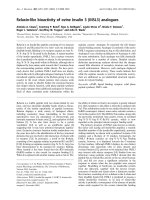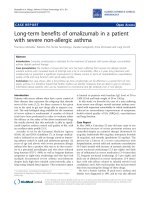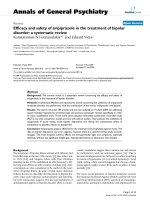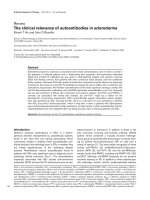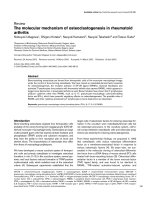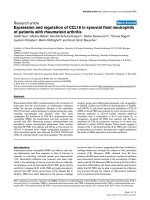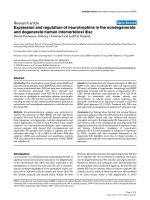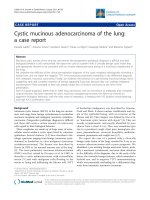Báo cáo y học: "Swine flu: provision of ventilation in a worst-case scenario" doc
Bạn đang xem bản rút gọn của tài liệu. Xem và tải ngay bản đầy đủ của tài liệu tại đây (35.68 KB, 1 trang )
Available online />Page 1 of 1
(page number not for citation purposes)
As a busy intensive care unit in a district general hospital in
the UK, we are intrigued by the worst-case scenario plans for
swine flu in our region and the ubiquitous algorithms that form
part of this planning.
A Department of Health document suggests for the purposes
of planning that, during a first major UK pandemic wave, the
peak clinical attack rate per week would be 8% [1]. Of these
patients, the hospitalization rate would be 2% – and 25% of
these would require intensive care if the capacity exists.
Our hospital serves a population of 220,000. In our region,
these estimates suggest that 352 patients will require
hospital admission each week during the peak. Using these
calculations, we could expect 88 patients per week to require
intensive care unit support.
In this hospital, there is the capacity to provide mechanical
ventilation to 25 patients (utilizing all ventilators and anaes-
thetic machines). Clearly, as this is primarily a disease
affecting the respiratory system, demand for mechanical
ventilation could vastly outstrip supply.
This lack of equipment will mean either severe rationing of
treatment or obtaining more ventilators from an external
source. At a time of heightened national demand, the latter is
unlikely to be achieved.
In the polio epidemic of the 1950s, patients were manually
ventilated by medical students and anyone else on hand as
the small number of cuirass ventilators was rapidly over-
whelmed by clinical cases [2]. When we receive our 26th
mechanically ventilated patient, rather than being unable to
provide positive pressure ventilation, we propose – in a
worst-case scenario – a return to basics.
Our solution to this problem is to order 200 disposable
bag–valve masks with adjustable positive end-expiratory
pressure valves. This solution is conveniently a cost-neutral
approach to the single organ support as we already use
disposable bag–valve masks throughout the trust. Clinical
staff are fully trained in their use, and support staff and
relatives could be utilized. Any excess stock could be used as
part of normal resource turnover.
A similar issue might occur with the requirement for renal
replacement therapy in large numbers of patients. In this
scenario, perhaps a similar solution would be a return to
continuous arteriovenous haemodiafiltration – which requires
only a simple disposable item rather than the complex and
limited resource of haemofiltration machines.
Competing interests
The authors declare that they have no competing interests.
References
1. Swine Flu UK Planning Assumptions [ />Publicationsandstatistics/Publications/PublicationsPolicyAnd
Guidance/DH_102892]
2. Wackers G: Modern anaesthesiological principles for bulbar
polio: manual IPPR in the 1952 polio-epidemic in Copen-
hagen. Acta Anaesthesiol Scand 1994, 38:420-431.
Letter
Swine flu: provision of ventilation in a worst-case scenario
Alex Doyle, Joseph Carter and Peter Young
Department of Anaesthesia, Queen Elizabeth Hospital, Gayton Road, Kings Lynn PE30 4ET, UK
Corresponding author: Alex Doyle,
Published: 28 October 2009 Critical Care 2009, 13:422 (doi:10.1186/cc8122)
This article is online at />© 2009 BioMed Central Ltd

